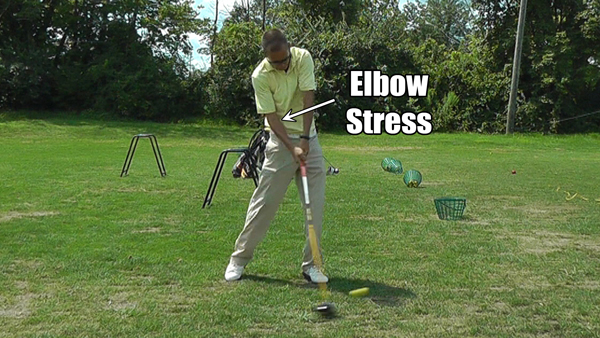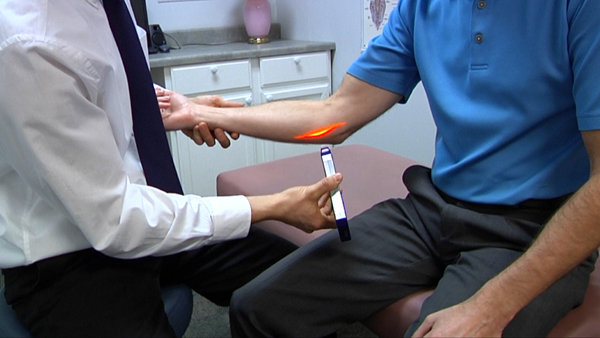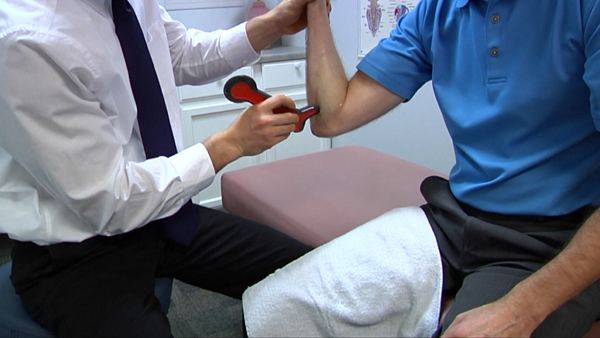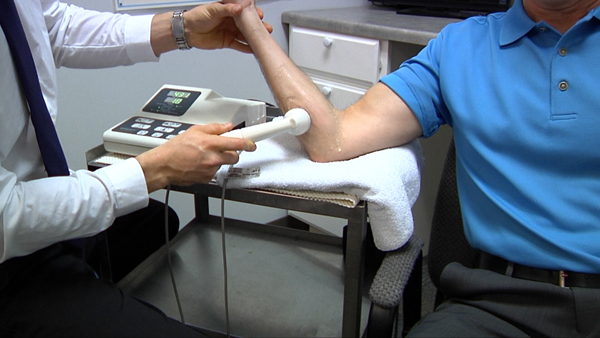If you are suffering from a painful condition in your arm known as Golfer’s Elbow, then here is some good news…we may be able to help you!
Golfer’s Elbow
Golfer’s Elbow is the name used to describe inflammation (pain, swelling, heat and/or redness) on the inside of the elbow joint. It’s not a real diagnosis, but rather, an acceptable replacement for the official one…Medial Epicondylitis.
Medial Epicondylitis
The inflammation that takes place on the inside (medial side) of the elbow joint happens over a lumpy mass of bone on the humerus (upper arm bone) anatomically known as the medial epicondyle…this is also the region that helps shape your funny bone. Muscles and tendons that flex the wrist (anteriorly and medially) attach here.
Whenever these muscles and tendons are subjected to repetitive forces they may begin to break down and tear, leading to inflammation at the medial epicondyle. Swinging a golf club over and over again is perhaps the most popular repetitive force activity known to cause this. See Figure 1 below:

Figure 1. Elbow stress on the medial (inside) of right elbow.
When any person, golfer or not, stresses the muscles and tendons near the medial epicondyle enough to cause tearing and inflammation, a diagnosis of Medial Epicondylitis is given. But because golfing is the most likely activity known to cause this, the injury has become synonymous with the sport and so the name Golfer’s Elbow is used when speaking in general terms.
With regards to golfers, they typically only develop Medial Epicondylitis in their dominant arm as this is the one subjected to the most stress on the inside of the elbow. The least dominant arm does not receive nearly as much and usually remains unaffected. For our right-handed golfer in Figure 1 above, the inside of his right elbow is receiving the most stress.
Other Symptoms
Besides inflammation, a person with Golfer’s Elbow may also develop weakness in their grip and pinch strength along with numbness and tingling in their ring and little finger, thereby affecting most of the upper extremity.
If you have ever had Golfer’s Elbow, or know someone who did, then you may know how most activities usually taken for granted suddenly become major obstacles.
Where one may have simply looked past the idea of having to brush their teeth, or turn a door knob, they are now presented with an immediate concern due to the pain those actions may cause.
Treatment of Golfer’s Elbow
The first thing a person should do to treat Golfer’s Elbow is rest the injured area, if possible. This will eliminate the irritant and give the inflammation a chance to subside.
Cold Laser Therapy
During this resting period, we like to recommend treatment with cold laser therapy. The cold laser is an excellent tool we have in our office that uses both near infrared and ultraviolet wavelengths. See Figure 2 below:

Figure 2. Cold laser therapy treatment.
Both of these wavelengths have the ability to induce photo-chemical (beneficial) reactions in the body such as:
- Increasing circulation
- Draws in much needed oxygen and nutrients
- Reduces inflammation and pain
- Increases cellular energy production
- Speeds up the repair process
As you can see, applying cold laser light therapy to the injured elbow is an absolute must to include in one’s treatment for Golfer’s Elbow, but, we can still do more to help.
Eliminate Fascia Restrictions Everywhere!
We also may recommend some deep tissue massage to break up any adhesions, or, scar tissue in the underlying fascia that may contribute to the pain, stiffness and/or loss of motion at the elbow joint. See Figure 3 below:

Figure 3. Deep tissue work.
Since fascia is a continuous form of connective tissue that runs throughout the body, adhesions in one area may ultimately affect another. Therefore, the entire body should be thoroughly scanned for tight fascia in order to effectively treat Golfer’s Elbow.
Ultrasound Therapy
Ultrasound may be recommended over the anterior and medial forearm muscles to help speed up the healing process…it may also be beneficial in the reduction of adhesions, elsewhere. See Figure 4 below:

Figure 4. Ultrasound therapy on muscles of anterior forearm.
Other beneficial therapies and/or exercises may be considered once an in-person consultation and evaluation are performed.
Schedule an Appointment
If you have Golfer’s Elbow (Medial Epicondylitis) or any type of pain on the inside of your elbow and are looking for relief, call our office today to schedule an appointment…we may be able to help you.